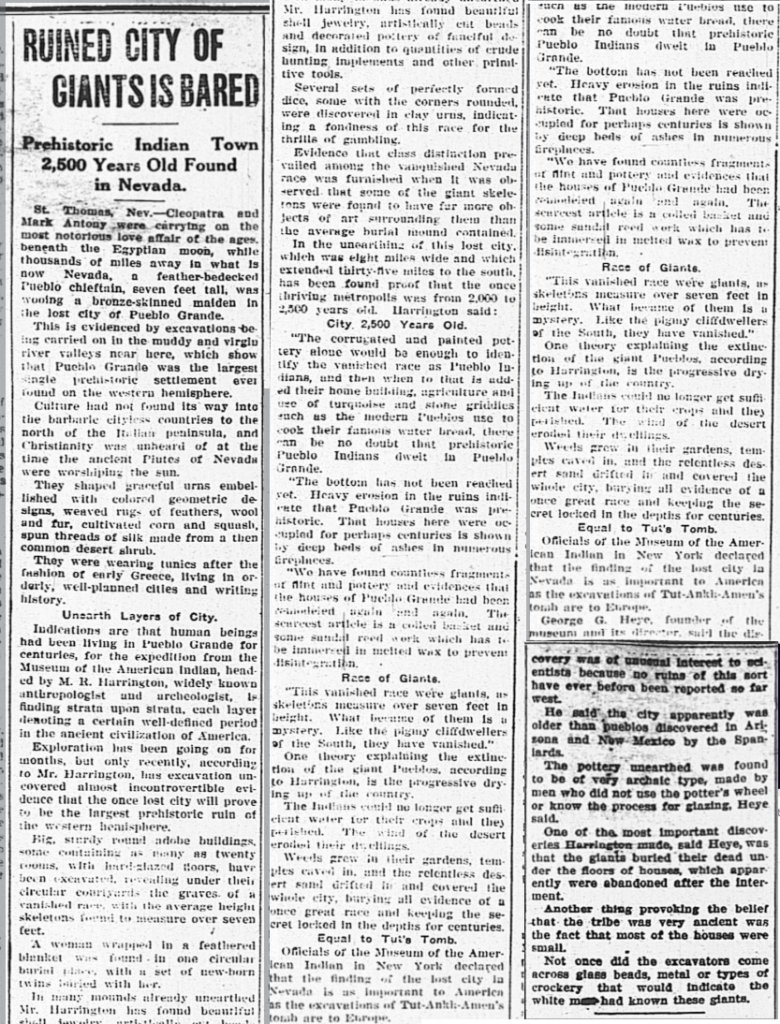Clark County – 7′ Pueblo Chieftain
“RUINED CITY OF GIANTS IS BARED – Prehistoric Indian Town 2,500 Years Old Found in Nevada.
St. Thomas,” Nev. — Cleopatra and Mark Antony were carrying on the most notorious love affair of the ages, beneath the Egyptian moon, while thousands of miles away in what is now Nevada, a feather-bedecked Pueblo chieftain, seven feet tall, was wooing a bronze-skinned maiden in the lost city of Pueblo Grande. This is evidenced by excavations being carried on in the muddy and virgin river valleys near here, which show that Pueblo Grande was the largest single prehistoric settlement ever found on the western hemisphere.
Culture had now found its way into the barbaric city-states countries to the north of the Italian peninsula, and Christianity was unheard of at the time the ancient Piutes of Nevada were worshiping the sun. They shaped graceful urns embellished with colored geometric designs, weaved rugs of feathers, wool and fur, cultivated corn and squash, spun threads of silk made from a then-common desert shrub. They were wearing tunics after the fashion of early Greece, living in orderly, well-planned cities and writing history.
Unearth Layers of City. Indications are that human beings had been living in Pueblo Grande for centuries, for the expedition from the Museum of the American Indian, headed by M. R. Harrington, widely known anthropologist and archaeologist, is finding strata upon strata, each layer denoting a certain well-defined period in the ancient civilization of America.
Exploration has been going on for months, but only recently, according to Mr. Harrington, has excavation uncovered almost incontrovertible evidence that the once lost city will prove to be the largest prehistoric ruin of the western hemisphere.
Big, sturdy round adobe buildings, some containing as many as twenty rooms, with hard-glazed floors, have been excavated. Surrounding under their circular courtyards the graves of a vanished race, the average height skeletons tend to measure over seven feet. A woman wrapped in a feathered blanket was interred in one circular burial pit, with a set of newborn twins buried with her.
In many mounds already unearthed, Mr. Harrington has found beautiful shell jewelry, artistically cut beads, and decorated pottery of graceful design, in addition to quantities of crude hunting implements and other primitive tools. Several sets of perfectly formed dice, some with the corners rounded, were discovered in clay urns, indicating a fondness of this race for the thrills of gambling.
Evidence that class distinction prevailed among the vanquished Nevada race was furnished when it was observed that some of the giant skeletons were found to have far more objects of art surrounding them than the average burial mound contained.
In the unearthing of this lost city, which was eight miles wide and which extended thirty-five miles to the south, has been found proof that the once thriving metropolis was from 2,000 to 2,500 years old. Harrington said: City. 2,500 Years Old. “The corrugated and painted pottery alone would be enough to identify the vanished race as Pueblo Indians, and that when to that is added their home building, agriculture, and use of turquoise and stone griddles such as the modern Pueblos use to cook their famous water bread, there can be no doubt that prehistoric Pueblo Indians dwelt in Pueblo Grande.
“The bottom has not been reached yet. Heavy erosion in the ruins indicates that Pueblo Grande was prehistoric. That houses here were occupied for perhaps centuries is shown by deep beds of ashes in numerous fireplaces.
“We have found countless fragments of flint and pottery and evidences that the houses of Pueblo Grande had an intricate system of irrigation canals that brought water from the Salt River to their fields. It is believed that at its peak, Pueblo Grande was home to over 1,000 people.”
Archaeological discoveries at Pueblo Grande have provided valuable insight into the lives and culture of the Hohokam people, who inhabited the area from around 1 AD to 1450 AD. The Hohokam were known for their advanced irrigation systems, which allowed them to farm in an otherwise arid environment, as well as their unique artistic and architectural styles.
Visitors to Pueblo Grande can explore the ruins of the ancient village, view artifacts in the museum, and participate in educational programs and tours. The site is a popular destination for tourists and history buffs alike, offering a fascinating glimpse into the past and the culture of the Hohokam people.
1. Nevada, Herrin Semi-Weekly Herald, 1 May 1925
